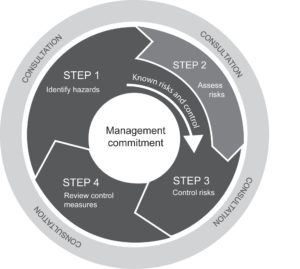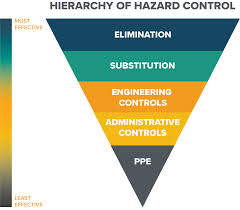What is done at each step in the risk control process and what is the role of workers at each step?
The four steps in controlling risks to eliminate them or reduce them to the lowest possible levels before they cause injuries are to:
- identify the hazards
- assess the risks
- control risks
- review control measures.

The risk management or risk control process
‘How to manage work health and safety risks – Code of Practice’ Safe Work Australia
Step 1 – Identify hazards
Identifying hazards in the workplace involves finding things and situations that could potentially cause harm to people. Hazards generally arise from the following aspects of work and their interaction:
- physical work environment
- equipment, materials and substances used
- work tasks and how they are performed
- work design and management.
In general, a number of methods are used to identify hazards. These include workplace inspections, consultation with employees by both formal structures and informal discussions, safety audits and observation, risk assessments of plant, equipment, tasks etc, injury and illness records, accident and incident investigations.
Workers doing tasks and/or operating machinery are most familiar with that task and machinery, and may be the first to identify any hazards or risks associated with their work and work area. You don’t want to be injured as a result of the hazard. You should report the hazard to your supervisor immediately and the supervisor should take action to eliminate or reduce the hazard. If you are still not satisfied you may report the hazard to your health and safety representative, the health and safety manager or the union.
Step 2 – Assess risks
A risk assessment involves considering what could happen if someone is exposed to a hazard and the likelihood of it happening. A risk assessment can help you determine:
- how severe a risk is
- whether any existing control measures are effective
- what action you should take to control the risk
- how urgently the action needs to be taken.
Risk assessment is the responsibility of management. Management will generally consult with workers about the hazards that may be associated with the work they are doing. As the operator of that task you have the knowledge and experience to help management assess the risks associated with your job and help identify control measures to reduce the risks.
Step 3 – Control risks
The most important step in managing risks involves eliminating them if possible, or if that is not possible, minimising the risks as low as possible.
Workers and their representatives who will be directly affected by this decision are consulted about possible controls. For example operators of plant and equipment are trained and experienced and most likely to have ideas about suitable control measures and their implementation.
There are many ways to control risks. Some control measures are more effective than others. It is important to select control measures that eliminate the risks or reduce them to the lowest possible levels. This may involve a single control measure or a combination of different controls that together provide the highest level of protection.
Some problems can be fixed easily and should be done straight away, while others will need more effort and planning to resolve. Of those requiring more effort, you should prioritise areas for action, focusing first on those hazards with the highest level of risk.
The various ways of controlling can be organised from the most effective method to the least effective. This is called the hierarchy of control as detailed in the following table.

Example
Elimination : Eliminate manual transport of hooks by installing a hook line.
Substitution : Substitution of metal hooks with lightweight durable plastic hooks on the chain will reduce noise levels.
Isolation : A noisy machine may be enclosed to reduce the noise levels.
Engineering controls : Acid treatment of floors to lift absorbed fatty substances followed by resurfacing using resin and graphite mix to reduce slip hazards.
Administrative controls : Rotation of trained workers.
Personal Protective Equipment : Moisture resistant aprons, abdominal protective aprons, hand protection, head protection.
